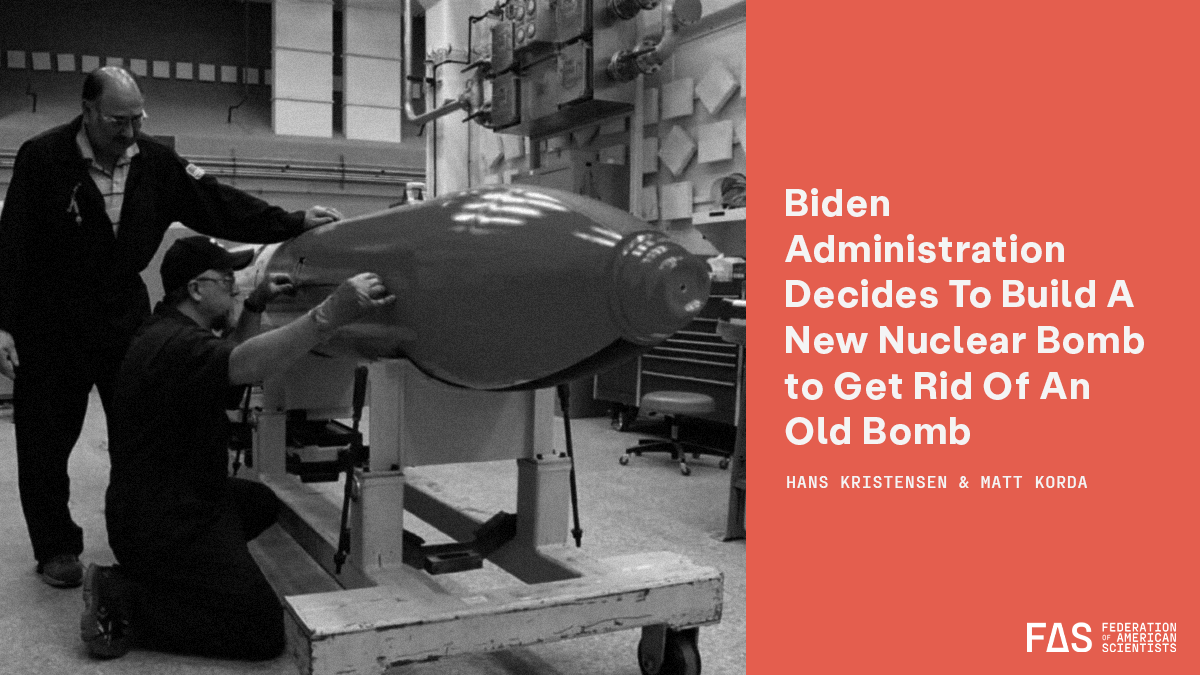
Biden Administration Decides To Build A New Nuclear Bomb to Get Rid Of An Old Bomb
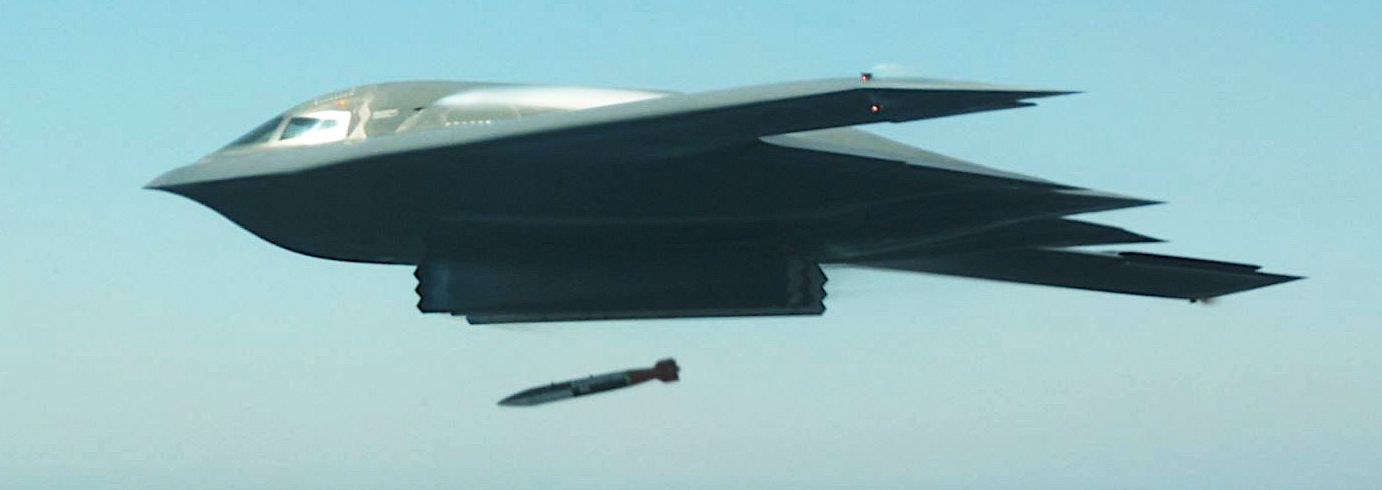
A B-2 bomber drops an unarmed B61-12 bomb in a trial. The planned B61-13, which seems intended to persuade Congress to allow retirement of the B83-1, would look the same and arm the new B-21 bomber.
[UPDATED] The Biden administration has decided to add a new nuclear gravity bomb to the US arsenal. The bomb will be known as the B61-13.
The decision to add the B61-13 comes shortly after another new nuclear bomb – the B61-12 – began full-scale production last year and is currently entering the nuclear stockpile. The administration stated that it would not increase the number of weapons in the arsenal and that any B61-13s would come at the expense of the long-planned B61-12.
According to defense officials, the B61-13 will use the warhead from the B61-7 but will be modified with new safety and use-control features as well as a guided tail kit (like the B61-12) to increase the bomb’s accuracy compared with the B61-7.
Although officials assured us that the B61-13 plan is not due to new developments in the target set, the press material from the Pentagon is more direct: B61-13 will “provides us with additional flexibility” by “providing the President with additional options against certain harder and large-area military targets.”
Like the B61-7, the B61-13 will be designed for delivery by strategic bombers: the future B-21 and, until it is retired, possibly also the B-2. It is not intended for delivery by dual-capable fighters. This decision to build the B61-13, however, appears to have less to do with a military need than striking a political deal to get rid of the last megaton-yield weapon in the US arsenal: the B83-1. This weapon was originally slated for retirement under President Obama until it was resurrected by the Trump administration; it has since become a focal point of the battle between the Biden administration, which wants to retire it, and congressional hardliners, who want to keep it.
Change Of Plan
The case for the B61-13 is strange. For the past 13 years, the sales pitch for the expensive B61-12 has been that it would replace all other nuclear gravity bombs. By re-using the B61-4 warhead, adding new safety and use-control features, and increasing accuracy with a guided tail kit, the agencies initially argued that it would be a consolidation of four existing types (B61-3/4/7/10) into a single type of gravity bomb.
Military officials have explained countless times that the B61-12 would be able to cover all gravity missions with less collateral damage than large-yield bombs. Increasing the bomb’s accuracy was the key reason why the tail kit was added, replacing the older drag parachute system of the older weapons.
By reducing the number of bomb types, the administration argued, it would be possible to reduce the total number of gravity bombs in the arsenal by 50 percent and save a substantial amount of money. Moreover, by using a warhead for the B61-12 with the least amount of fissile material, the proliferation risk from theft would be reduced, so the argument went. When the B61-10 was retired in 2016, the pitch obviously changed to consolidating three bomb types, rather than four, into one. But the Obama administration also wanted to use it to replace the ultra-high yield B83-1 and eventually the B61-11 earth-penetrator.
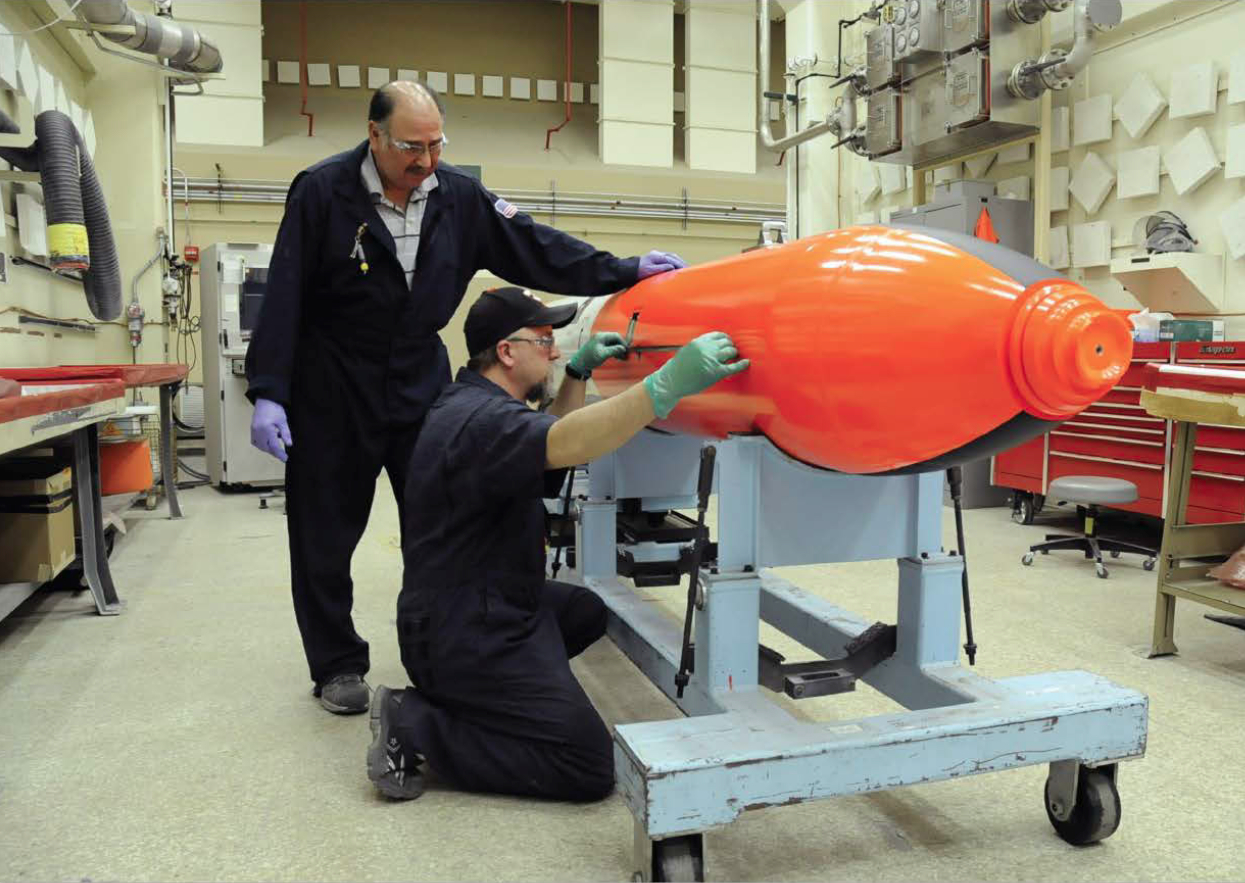
The Biden administration appears to have decided to build the new B61-13 nuclear bomb to persuade hardliners to get rid of the old B83-1 bomb.
The Trump administration had different interests, however, and its Nuclear Posture Review decided to retain the B83-1 (for reasons that remain unclear, and appear to have as much to do with undoing any decisions from the previous administration and little to do with military requirements or target sets) and leave the fate of the B61-11 unanswered.
When the Biden administration took over, its Nuclear Posture Review decided to proceed with retirement of the B83-1 but did not say anything about the B61-11. The Republican-controlled House did not agree and have used the years since to solicit hardline views that the B83-1 is somehow still needed.
Privately, however, Air Force and NNSA official disagreed. A high-yield gravity bomb is no longer needed and maintaining the B83-1 would cost a lot of money that could be better used elsewhere. Moreover, the NNSA production schedule is packed and adding a B83-1 life-extension program could jeopardize much more important programs. Although the B61-13 will add stress to this backlog, it will not increase the NNSA’s planned plutonium pit production schedule.
B61-13 Characteristics
Confusingly, the name B61-13 has already been used for another nuclear weapon: the future bomb intended to replace the B61-12 in the late-2030s and 2040s. That weapon was first described in NNSA’s Stockpile Stewardship and Management Plan in 2015 (see images below).
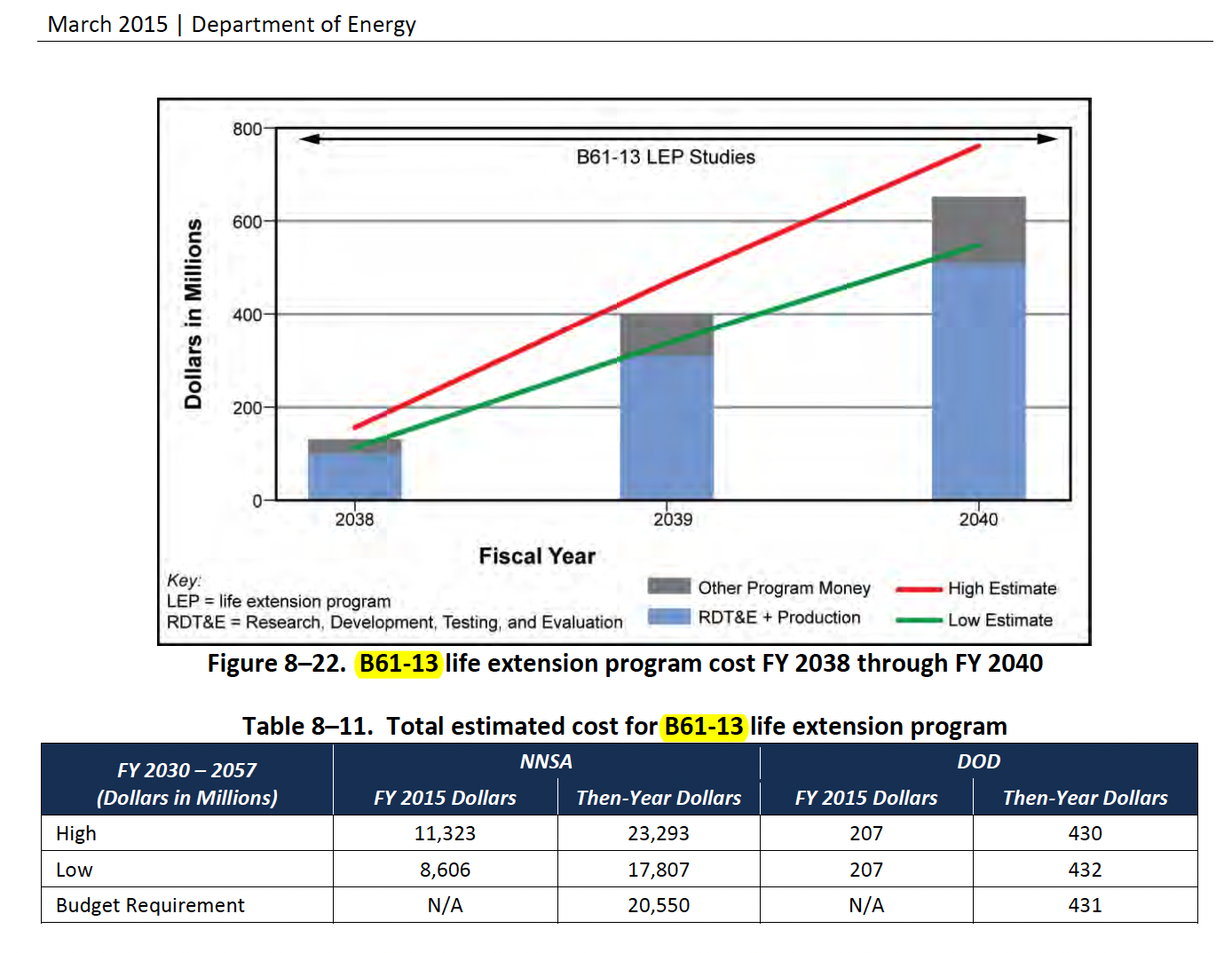
The B61-13 designation was previously given to another future nuclear bomb back in 2015.
The new B61-13 bomb will be the 13th modification of the B61 warhead design (see image below). These modifications have varied in physical appearances, yields, safety and use-control features, and delivery platforms. Five of these modifications remain in the stockpile (B61-3/4/7/11/12).
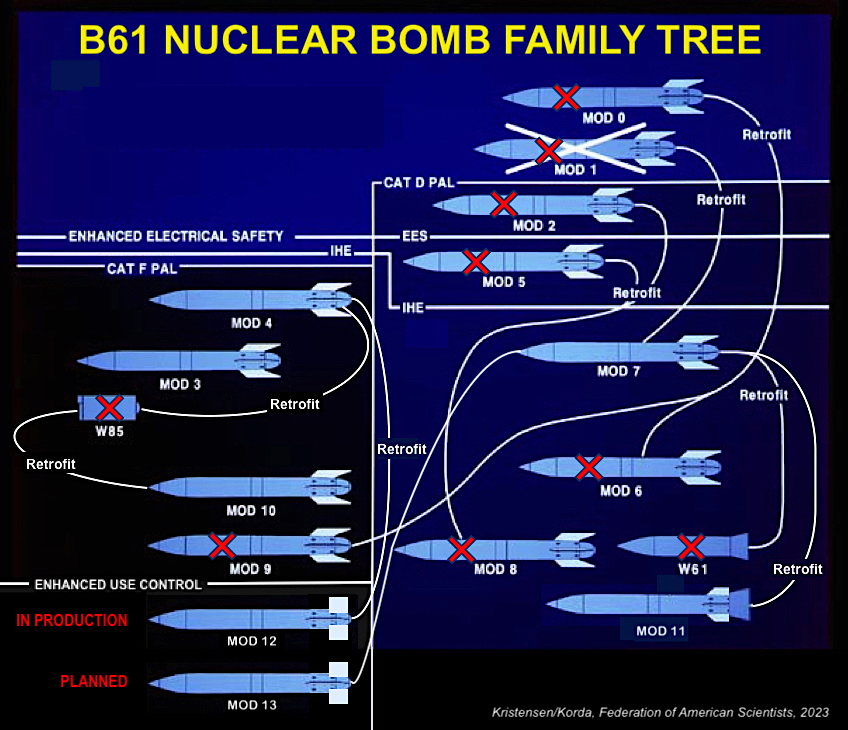
The B61-13 will be the 13th modification of the original B61 bomb. It will use the warhead from the B61-7 but with enhanced use- and security features and a guided tail kit like the B61-12 to increase accuracy.
The B61-13 will have the same maximum yield as the B61-7 (360 kilotons), according to defense officials, a significant increase compared with the 50-kiloton B61-12 it is intended to supplement. If detonated on the surface, a yield of 360 kilotons would cause significant radioactive fallout over large areas.
The effects of a 360-kiloton explosion are significantly greater than those that would result from a 50-kiloton explosion. The following map compared the radioactive fallout from a ground burst detonation in North Korea. Depending on target location and weather conditions, the fallout from a B61-13 could reach half-way across South Korea (simulation from Nukemap).
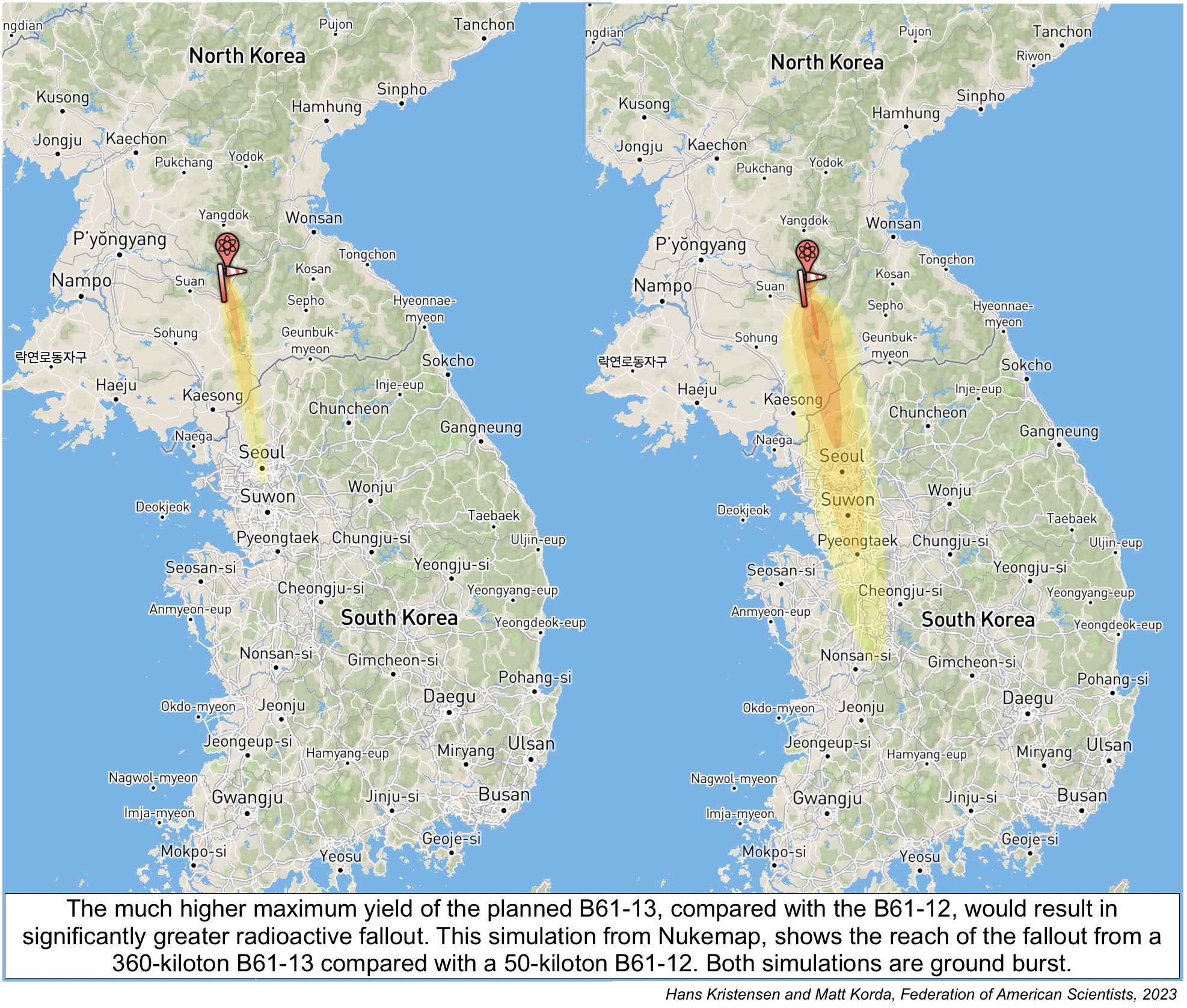
Similar to the B61-12, the B61-13 will likely also have limited earth-penetration capabilities (through soft soil), which will be enhanced by the addition of the guided tail kit. Due to the phenomenon of ground-shock coupling, the B61-13’s relatively high yield and accuracy will likely enable the bomb to strike underground targets with yields equivalent to a surface-burst weapon of more than one megaton. The B61-13 will also have lower-yield options (see table below).
Although government officials insist that the B61-13 plan is not driven by new developments in adversarial countries or a new military targeting requirement, increasing the accuracy of a high-yield bomb obviously has targeting implications. Detonating the weapon closer to the target will increase the probably that the target is destroyed, and a very hard facility could hypothetically be destroyed with one B61-13 instead of two B61-12s. The DOD says the B61-13 will “provides us with additional flexibility” by “providing the President with additional options against certain harder and large-area military targets.”
Once the B61-12 and B61-13 are produced and stockpiled, the older versions replaced, and the B83-1 retired, the changes to the gravity weapons inventory will look something like this:
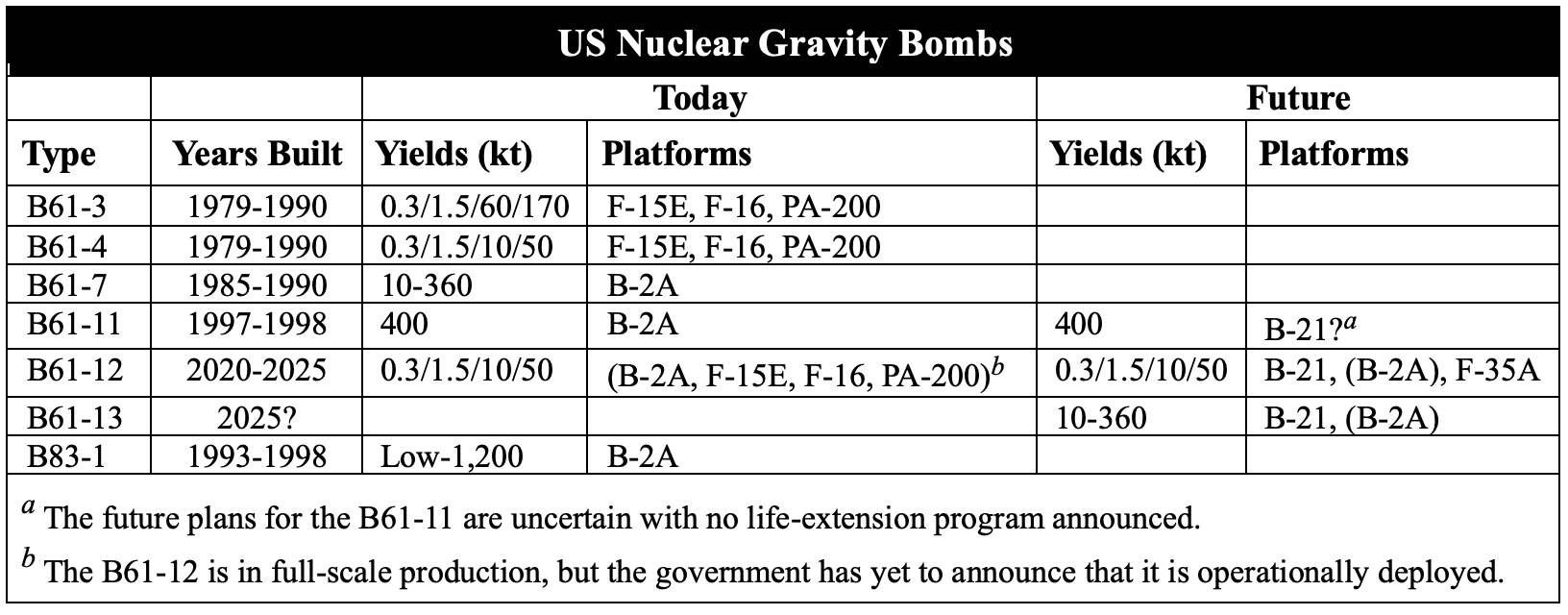
Although the B61-12 was previously said to also allow retirement of the B61-11 earth-penetrator, the B61-13 plan only appears intended to facilitate retirement of the B83-1. There is currently no life-extension program for the B61-11. The plan might be to allow it to age out. Officials say the B61-13 plan does not preclude that the United States potentially decides in the future to field a new nuclear earth-penetrator to replace the B61-11. But there is no decision on this yet.
Defense officials explain that the new B61-13 will not result in an increase of the overall number of warheads in the stockpile. The reason is that the administration plans to reduce the number of B61-12s produced by the number of B61-13s produced, so the total number of new bombs will ultimately be the same. The production plan for the B61-12 involved an estimated 480 bombs for both strategic bombers and dual-capable fighters. Since the bombers will now carry both B61-12 and B61-13 bombs (in addition to the new LRSO cruise missiles), and because the actual number of targets requiring a high-yield gravity bomb is probably small, it seems likely that the number of B61-13 bombs to be produced is very limited – perhaps on the order of 50 weapons – and that production will happen at the back end of the B61-12 schedule in 2025.
Unlike the B61-12s – of which a portion will be forward-deployed to Europe for use with NATO’s dual-capable aircraft – all of the B61-13s will be stored within the United States for use with the incoming B-21 bomber and the B-2 bomber (until it is replaced by the B-21). Nonetheless, because the B61-13 will use the same mechanical and electronic interface as the B61-12, the fighters that are destined to deliver the B61-12 will also be capable of delivering the B61-13. But the current plan is that the B61-13 is only for the bombers.
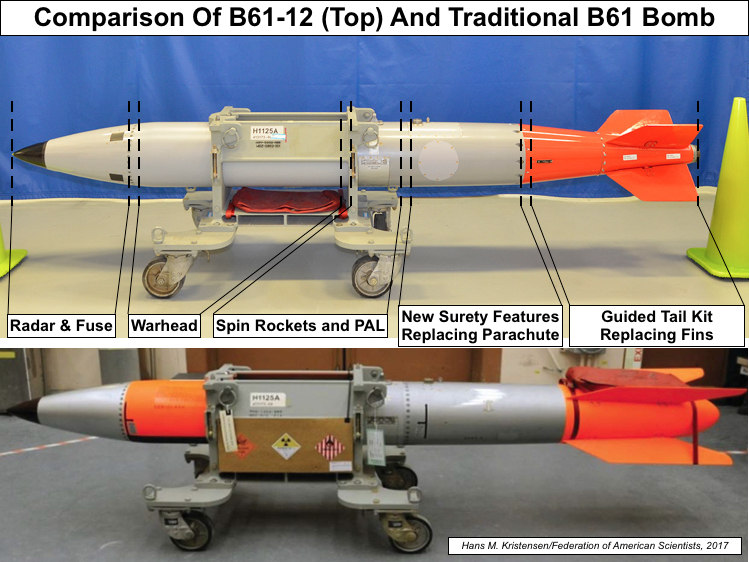
The B61-13 will look identical to the B61-12 (top) but use a much more powerful warhead from the B61-7. It is intended for delivery by bombers but can technically also be delivered by fighter jets (although that is not planned).
A Political Nuclear Bomb
The military justification for adding the B61-13 to the stockpile is hard to see. Instead, it seems more likely to be a political maneuver to finally get rid of the B83-1.
Defense officials say that the decision is not related to current events or developments in China, Russia, or other potential adversaries. Nor is the administration’s decision a product of the hard and deeply buried target capability study mentioned in the 2022 Nuclear Posture Review.
The B61-13 is a separate decision, they explain.
The military doesn’t need an additional, more powerful gravity bomb. In fact, Air Force officials privately say the military mission of nuclear gravity bombs is decreasing in importance because of the risk of putting bombers and their pilots in harm’s way over heavily defended targets – particularly as long-range missiles are becoming more capable.
To that end, the military mission of the B61-13 is somewhat of a mystery, especially given that the LRSO will also be arming the bombers and that the United States has thousands of other high-yield weapons in its arsenal.
Instead, what appears to have happened is this: after defense hardliners blocked the administration’s plans to retire the B83-1, the administration likely agreed to retain the B61-7 yield in the stockpile in the form of a modern bomb modification (B61-13) that is easier and cheaper to maintain, so that they can finally proceed with the retirement of the B83-1.
As such, the B61-13 will be the second “political” weapon in recent memory. The first was the low-yield W76-2 warhead fielded in late-2019 on the Trident submarines. The next one could be a nuclear sea-launched cruise missile (SLCM-N), if defense hawks have their way.
Additional Information
• US nuclear weapons, 2023
• The B61 Family of Nuclear Bombs
This research was carried out with generous contributions from the New-Land Foundation, Ploughshares Fund, the Prospect Hill Foundation, Longview Philanthropy, and individual donors.
The Federation of American Scientists applauds the United States for declassifying the number of nuclear warheads in its military stockpile and the number of retired and dismantled warheads.
North Korea may have produced enough fissile material to build up to 90 nuclear warheads.
Secretary Austin’s likely certification of the Sentinel program should be open to public interrogation, and Congress must thoroughly examine whether every requirement is met before allowing the program to continue.
Researchers have many questions about the modernization of Pakistan’s nuclear-capable aircraft and associated air-launched cruise missiles.